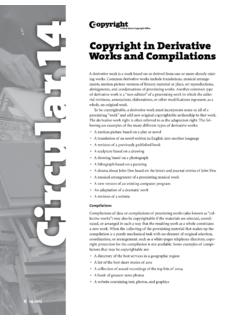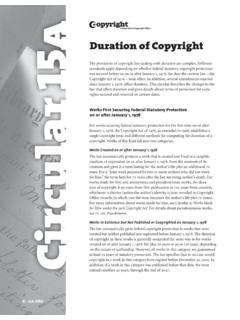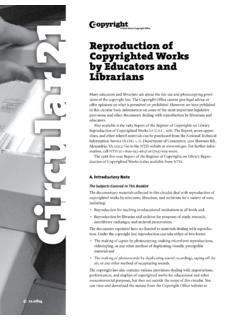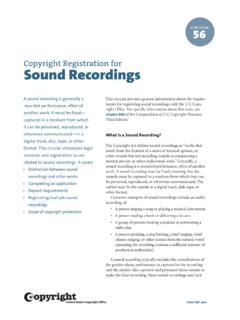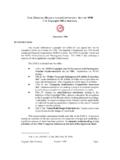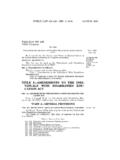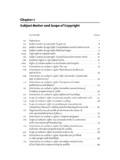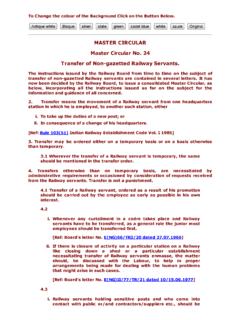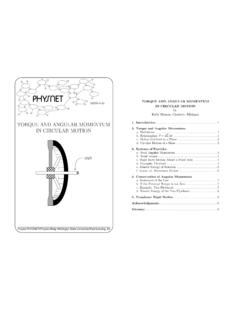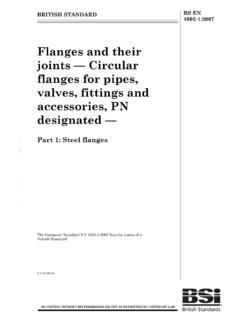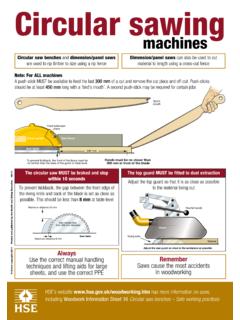Transcription of Circular 1 Copyright Basics
1 1 Copyright is a form of protection provided by the laws of the United States to the authors of original works of authorship that are fixed in a tangible form of expression. An original work of authorship is a work that is independently created by a human author and possesses at least some minimal degree of creativity. A work is fixed when it is captured (either by or under the authority of an author) in a sufficiently permanent medium such that the work can be perceived, reproduced, or communicated for more than a short time.
2 Copyright protection in the United States exists automatically from the moment the original work of authorship is Works Are Protected?Examples of copyrightable works include Literary works Musical works, including any accompanying words Dramatic works, including any accompanying music Pantomimes and choreographic works Pictorial, graphic, and sculptural works Motion pictures and other audiovisual works Sound recordings, which are works that result from the fixation of a series of musical, spoken, or other sounds Architectural worksThese categories should be viewed broadly for the purpose of registering your work.
3 For example, computer programs and certain compilations can be registered as literary works ; maps and technical drawings can be registered as pictorial, graphic, and sculptural works. Copyright is a form of protection provided by law to authors of original works of authorship from the time the works are created in a fixed form. This Circular provides an overview of basic facts about Copyright and Copyright registration with the Copyright Office. It covers Works eligible for protection Rights of Copyright owners Who can claim Copyright Duration of copyrightCopyright BasicsCopyright Basics2note: Before 1978, federal Copyright was generally secured by publishing a work with an appro-priate Copyright notice.
4 Works that were in the public domain on January 1, 1978, when the 1976 Copyright Act took effect, remain in the public domain under the 1976 Are the Rights of a Copyright Owner? Copyright provides the owner of Copyright with the exclusive right to Reproduce the work in copies or phonorecords2 Prepare derivative works based upon the work Distribute copies or phonorecords of the work to the public by sale or other transfer of owner-ship or by rental, lease, or lending Perform the work publicly if it is a literary, musical, dramatic, or choreographic work; a panto-mime.
5 Or a motion picture or other audiovisual work Display the work publicly if it is a literary, musical, dramatic, or choreographic work; a pan-tomime; or a pictorial, graphic, or sculptural work. This right also applies to the individual images of a motion picture or other audiovisual work. Perform the work publicly by means of a digital audio transmission if the work is a sound recordingCopyright also provides the owner of Copyright the right to authorize others to exercise these exclusive rights, subject to certain statutory Is Not Protected by Copyright ?
6 Copyright does not protect Ideas, procedures, methods, systems, processes, concepts, principles, or discoveries Works that are not fixed in a tangible form (such as a choreographic work that has not been notated or recorded or an improvisational speech that has not been written down) Titles, names, short phrases, and slogans Familiar symbols or designs Mere variations of typographic ornamentation, lettering, or coloring Mere listings of ingredients or contentsFor more information, see Works Not Protected by Copyright ( Circular 33).
7 Who Can Claim Copyright ?The Copyright in a work initially belongs to the author(s) who created that work. When two or more authors create a single work with the intent of merging their contributions into inseparable or inter-dependent parts of a unitary whole, the authors are considered joint authors and have an indivisible interest in the work as a whole. By contrast, if multiple authors contribute to a collective work, each Copyright Basics3author s individual contribution is separate and distinct from the Copyright ownership in the collec-tive work as a whole.
8 Works made for hire are an important exception to the general rule for claiming Copyright . When a work is made for hire, the author is not the individual who actually created the work. Instead, the party that hired the individual is considered the author and the Copyright owner of the work. Whether a work is made for hire is determined by the facts that exist at the time the work is created. There are two situations in which a work may be made for hire:1. When the work is created by an employee as part of the employee s regular duties, or2.
9 When an individual and the hiring party enter into an express written agreement that the work is to be considered a work made for hire and the work is specially ordered or commis-sioned for use as: A compilation A contribution to a collective work A part of a motion picture or other audiovisual work A translation A supplementary work An instructional text A test Answer material for a test An atlasThe concept of work made for hire can be complicated and has serious consequences for both the individual who creates the work and the hiring party who is considered to be the author and copy-right owner of the work.
10 For more information, see Works Made for Hire ( Circular 30).note: Mere ownership of a copy or phonorecord that embodies a work does not give the owner of that copy or phonorecord the ownership of the Copyright in the of Copyright OwnershipAny or all of the Copyright owner s exclusive rights, or parts of those rights, can be transferred. The transfer, however, generally must be made in writing and signed by the owner of the rights conveyed or the owner s authorized agent. Transferring a right on a nonexclusive basis does not require a writ-ten can bequeath a Copyright by will or pass it along as personal property under applicable state laws of intestate succession.
